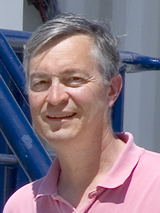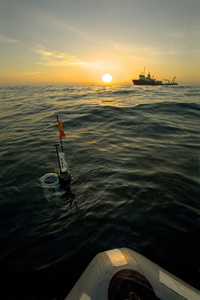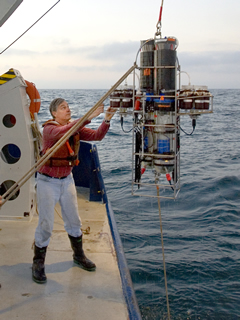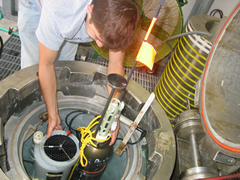Bobbing for carbon
Think your garden is green? The blue waters of the oceans are actually much greener. Every year, microscopic marine plants called phytoplankton convert roughly 50 petagrams-50 trillion kilograms-of carbon dissolved in ocean surface waters into living tissue. That's half of all the photosynthesis that occurs on the planet, and it happens at an astoundingly rapid pace.

"If I look out my window, I can see the same trees standing mostly unchanged year in and year out. The photosynthetic biomass on land is there for decades before being replaced. In the ocean, the extreme opposite occurs; the plants that are here one week have been eaten by the end of the week," says Jim Bishop, a Berkeley professor of earth and planetary science.
Bishop studies how plankton turnover contributes to the global carbon cycle. The amount of carbon these marine organisms take up, and how much gets entombed in the deep sea when they die, are key indicators of how earth is coping with global climate change. The process is critical to understanding and predicting present and future levels of atmospheric carbon dioxide. Yet the transitory nature of plankton, the size of the oceans, and often treacherous seas mean that plankton measurements from ships is spotty at best. "If I go to sea to study phytoplankton every three months, sixteen generations will have elapsed between the population I saw the first time and the one I saw later, and I have no idea how it evolved," Bishop says.

To overcome these hurdles, Bishop has developed a fully autonomous phytoplankton sampling robot. Dubbed the Carbon Explorer, it is designed to rise to the surface and sink back down to 1,000 meters, sampling plankton and ocean conditions all the way. Bishop's robots cost about $30,000 each, the equivalent of operating a research vessel for a single day, yet can continue gathering data twice a day in absence of ships for over a year. And they are tough. One operated in the ice surrounding Antarctica for an entire winter, transmitting data to shore weekly and emerging unscathed in spring.
An international project called ARGO has launched a fleet of more than 3,000 similar robots that have been collecting ocean temperature and salinity profiles every 10 days since 1999. Bishop's floats, however, can receive commands, carry an ingenious suite of plankton measuring instruments, and profile the water column daily to capture the diurnal rhythms of plankton growth and death.

Bishop has designed a new robot, the Carbon Flux Explorer, that can follow carbon sedimentation as well. A funnel collects falling particles for three-way analysis with a digital camera. A rotating polarized light filter can highlight species such as foraminifera that have calcium carbonate shells; a ring light illuminates the delicate silica shells of radiolarians and diatoms; and simple transmitted light illuminates all of the collected particles. "Is it an arm, somebody's leg, a fecal pellet, a shell, or a blob of carbon? By looking at the garbage of the ocean's ecosystem, we can tell who was grazing and floating in the water column besides measuring carbon sedimentation," Bishop says. Comparisons with physical measurements can reveal how water mixing, temperature, seasons and storms affect plankton dynamics. Sea trials for the Carbon Flux Explorer will take place later this summer in coastal waters near San Diego.

As organisms from microscopic to krill to fish to whales graze on plankton, their dinner leavings fall into the deep ocean. Climatologists have averaged decades of sparse ship observations to estimate that marine organisms sequester about 10 petagrams of carbon per year through sinking particles. But that may be changing in an era when humans are fishing krill and other agents involved in carbon sedimentation. Shifts in plankton populations and ocean acidification due to global warming might affect the amount of carbon being stashed in the abyss. Such a weakened biological carbon pump would alter seawater chemistry and the ocean's capacity to sponge up more atmospheric carbon dioxide. Measures of how the ocean is changing will allow climate modelers to improve their future forecasts.
And as biofuels and other methods to limit carbon emissions are put into place, the floats can record how the ocean reacts, allowing nations to adjust accordingly. "If implemented on a grand scale like ARGO, they could do the inventory of carbon and monitor carbon sedimentation in the ocean in real time," Bishop says, and guide efforts to keep global climate hospitable both now and in the future.
Related Web Sites
- Jim Bishop, Earth and Planetary Sciences
- Ocean Biogeochemical Processes Group-James K. Bishop
- "Ocean Carbon: A Dent in the Iron Hypothesis," by Paul Preuss, Berkeley Lab News Center, 06 May 2009
- "Carbon Explorers Fly Solo," Did you ever wonder?, Berkeley Lab
- "Robotic floats for monitoring ocean carbon launched in the Pacific," by Paul Preuss, Berkeley Lab News Center, 24 April 2001
This article originally appeared in Science Matters@Berkeley, vol. 7, issue 53, published by the College of Letters and Science.
